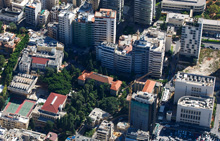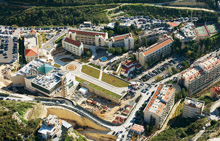Facilities Management FM
Plan, Build, Operate and MaintainConstruction
In order to respond to growing space and educational programs needs, LAU adopted a Capital Projects (Construction and Renovations) Program and allocated a Capital Budget Plan. In addition, two procedures were devised to manage and implement the program: The Capital Projects Management Procedures (for projects above $500,000) and the Miscellaneous Projects Management Procedures (for projects below $500,000).
Beirut Campus
Byblos Campus
Capital Projects Phases
Project Initiation
The Board of Trustees approves the initiation of a capital project listed in the Capital Budget Plan, after which the VPHRUS forms the project’s Steering Committee. The Steering Committee is responsible for the project’s management and implementation throughout all phases.
The Steering Committee is composed of:
- Chairperson: Vice President for Human Resources and University Services (VPHRUS), or assignee
- Vice President for Finance (VPF), or assignee
- Assistant Vice President for Facilities Management (AVPFM)
- Assistant Vice President for Information Technology (AVPIT)
- Executive Director of Program Management and Contract Administration (PM&CA)
- End-Users Representative(s): Recommended by relevant Vice President(s)
- Any other person recommended by VPHRUS
Project Planning and Owner Project Requirements
Once the Steering Committee is formed, the Facilities Management team prepares the project’s plan and the Owner Project Requirements (OPR) in coordination with relevant stakeholders and end-users. The plan and OPR are reviewed and approved by the Steering Committee.
Selection of Consultants
The designers, engineering firms, technical advisors, project management firms, and general consultants are selected by the Steering Committee as follows:
- Renowned firms in relevant fields are invited to participate in a prequalification process. The invited firms should provide documentation demonstrating their experience, capabilities, and legal and financial status. Note that the prequalification processes might be carried out for each project individually or for groups of projects when necessary and/or periodically.
- A shortlist of prequalified firms is prepared.
- The shortlisted firms are invited to participate in a “Request for Proposal” and/or competition process based on the approved project plan and OPR. Successful candidates are awarded the services and works.
Design and Tender Documents Phase
The design work commences once all consultants are selected. The design passes through the schematic, preliminary and permit, design development, and tender drawings and documents cycles. The LAU technical review team reviews the deliverables after each cycle.
Bidding and Tender Phase
Upon the completion of tender documents and drawings and the preparation of the cost estimate and the approval of the Steering Committee and the Board of Trustees and in accordance with the Capital Projects Management Procedures, contractors are selected as follows:
- Renowned contractors are invited to participate in a prequalification process. The invited firms should provide documentation demonstrating their experience, capabilities, and legal and financial status. Note that the prequalification processes might be carried out for each project individually or for groups of projects when necessary and/or periodically.
- A shortlist of contractors is prepared.
- Tendering procedures and conditions of contract documents are prepared and submitted for approval by the Steering Committee and Legal Counsel. The shortlisted contractors are then invited to participate and submit tenders for the project’s works.
- The submitted tenders are evaluated and forwarded to the Steering Committee with recommendations regarding the selection of a contractor. The Steering Committee reviews and approves the evaluation and selection. The outcome is reported to the BOT for final clearance and approval, upon which the contractor is awarded the works.
Check bidding for more information.
Construction Phase
A completion of the selection phase, a contract is signed with the project’s contractor. The execution works commence after the contractor has provided the insurance policies, performance guarantees, schedule of works, and other necessary documentation. All works (including shop-drawings, material submittals, testing and commissioning) are directly supervised by the consultants and Facilities teams.
Furnishing and Moving-In
Once the construction works are completed and handed over to LAU, furnishing packages with necessary specifications are prepared in coordination with the end-users. The necessary items (furniture, equipment and fitting-out items) are then procured in accordance with the University procurement procedures. Building occupants move immediately upon installation.
Project Closeout
After the project has been successfully completed and the defect liability period ends, all relevant accounts and documentations are closed out and reported to the Steering Committee.
Miscellaneous Projects Phases
Project Initiation
Facilities prepares conceptual documentation, drawing and cost estimates based on end-user’s requests and/or university planning requirements.
Design and Tender Documents Phase
Normally, miscellaneous projects are designed in-house by Facilities, with the assistance of IT where applicable. The design passes through the schematic, preliminary and permit (where applicable), design development, and tender drawings and documents cycles.
Bidding and Tender Phase
Upon the completion of tender documents and drawings and the preparation of the cost estimates, budget allocation requests are filled in and submitted to the Administration for approval, after which contractors are selected as follows:
- Periodically, renowned contractors are invited to participate in a prequalification process, during which they should provide documentation demonstrating their experience, capabilities, and legal and financial status.
- A shortlist of qualified contractors is prepared.
- Tendering procedures and conditions of contract documents are prepared and submitted for approval by the Administration and the Legal Counsel.
- Selected shortlisted contractors are invited to submit tenders for the project’s works.
- The submitted tenders are evaluated and forwarded to the Administration, with recommendations regarding the selection of a contractor. The Administration reviews and approves the selection of the contractor, who is then awarded the works.
Check bidding for more information.
Construction Phase
Where applicable, once the construction works are completed and handed-over to LAU, the necessary furnishing packages are prepared in coordination with the end-users. The related items (furniture, equipment and fitting-out items) are then procured in accordance with the University procurement procedures. The occupants move in immediately upon installation.
Furnishing and Moving-In
Where applicable, when the construction works are completed and handed-over to LAU, the necessary furnishing packages will be prepared in coordination with the end-users. The related material (furniture, equipment and fitting-out items) will then be procured in line the University procurement procedures and installed. Right after the occupants will move-in the premises.
Project Closeout
After the project has been successfully completed and the defect liability period ends, all relevant accounts and documentation are to be closed out and reported to the Administration.

![[Photo]](https://fm.lau.edu.lb/projects/images/img-construction11.jpg)
![[Photo]](https://fm.lau.edu.lb/projects/images/img-construction10.jpg)
![[Photo]](https://fm.lau.edu.lb/projects/images/img-construction09.jpg)
![[Photo]](https://fm.lau.edu.lb/projects/images/img-construction07.jpg)
![[Photo]](https://fm.lau.edu.lb/projects/images/img-construction06.jpg)
![[Photo]](https://fm.lau.edu.lb/projects/images/img-construction05.jpg)
![[Photo]](https://fm.lau.edu.lb/projects/images/img-construction03.jpg)
![[Photo]](https://fm.lau.edu.lb/projects/images/img-construction02.jpg)
![[Photo]](https://fm.lau.edu.lb/projects/images/img-construction01.jpg)